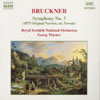Bruckner Symphony No. 3 (1873 Original Version, ed. Nowak)
A rare outing for the 1873 version of Bruckner's Third, in an inspired reading
View record and artist detailsRecord and Artist Details
Composer or Director: Anton Bruckner
Label: Naxos
Magazine Review Date: 5/2000
Media Format: CD or Download
Media Runtime: 78
Mastering:
DDD
Catalogue Number: 8 553454

Tracks:
| Composition | Artist Credit |
|---|---|
| Symphony No. 3 |
Anton Bruckner, Composer
Anton Bruckner, Composer Georg Tintner, Conductor Royal Scottish National Orchestra |
Author: Richard Osborne
This original (1873) version of Bruckner's Third Symphony is his longest symphony, a work of epic intent filled with youthful fire. It has rarely been recorded and is rarely played, yet this is the work as it was meant to be. The two revisions which Bruckner published are merely scaled-down (and trussed up) versions of the music. Had Robert Haas's fully prepared and engraved edition of the 1873 version not been incinerated in a raid on Leipzig in 1944 (happily, an uncorrected proof later turned up in Winterthur) the work's recorded history might have been very different. In the event, it was not until 1977 that the Bruckner/Haas edition finally appeared in print, edited by Nowak, since when it has been recorded by Inbal (1983) and Norrington (EMI, 1/97 - nla).
The Inbal recording is admirable in almost every way, a consistently satisfying version orchestrally and technically. What it lacks is the danger and visionary daring of parts of Tintner's reading. The contrast is most marked in the first movement where Tintner, like Inbal but unlike Norrington, judges the written instructionGemassigt, misterioso ('Moderate, mysterious') to be all-important, the alla breve instruction a secondary consideration. Yet Tintner goes further than Inbal. As early as fig A (1'23''), it is clear that persistence of pulse is not a priority. In Tintner's performance the 'statuesque juxtaposition of masses' (Robert Simpson's phrase) is the thing. In other words, he conducts the Third Symphony as he (and, indeed, all other good Brucknerians) would conduct the Fifth.
It makes for a revelatory reading of the first movement, not only in the great columnar annunciations but in the several sublimely realised points of transition. Clock-watchers will no doubt be fascinated by the relative statistics: Norrington 18'48'', Inbal 24'00'', Tintner 30'34''. In fact, the Tintner doesn't seem slow. Vivid yet profound are the words that most immediately come to mind. It is Tintner at his greatest. Coming near the end of a cycle which he knew would be the end of both his career and his life, it is a worthy memorial.
The sound he draws from the RSNO - the strings in particular - has an almost Sibelian spareness to it, as does the recording, where space has been cleared for tuttis that are clear, fierce, and unclaustrophobic. Clearing space involves keeping the orchestra slightly at a distance, at some cost to the winds - the woodwinds in particular - in the two outer movements and in the otherwise wonderfully vibrant and beautifully paced Scherzo and Trio.
As has occasionally been the case with these Tintner recordings, the finale makes less of a mark. The playing of the polka in the crucial polka-cum-chorale seems under-rehearsed, bland and uninvolved; a pity since this juxtaposition of dance hall and funeral rite is one of Bruckner's most graphic inventions.'
The Inbal recording is admirable in almost every way, a consistently satisfying version orchestrally and technically. What it lacks is the danger and visionary daring of parts of Tintner's reading. The contrast is most marked in the first movement where Tintner, like Inbal but unlike Norrington, judges the written instruction
It makes for a revelatory reading of the first movement, not only in the great columnar annunciations but in the several sublimely realised points of transition. Clock-watchers will no doubt be fascinated by the relative statistics: Norrington 18'48'', Inbal 24'00'', Tintner 30'34''. In fact, the Tintner doesn't seem slow. Vivid yet profound are the words that most immediately come to mind. It is Tintner at his greatest. Coming near the end of a cycle which he knew would be the end of both his career and his life, it is a worthy memorial.
The sound he draws from the RSNO - the strings in particular - has an almost Sibelian spareness to it, as does the recording, where space has been cleared for tuttis that are clear, fierce, and unclaustrophobic. Clearing space involves keeping the orchestra slightly at a distance, at some cost to the winds - the woodwinds in particular - in the two outer movements and in the otherwise wonderfully vibrant and beautifully paced Scherzo and Trio.
As has occasionally been the case with these Tintner recordings, the finale makes less of a mark. The playing of the polka in the crucial polka-cum-chorale seems under-rehearsed, bland and uninvolved; a pity since this juxtaposition of dance hall and funeral rite is one of Bruckner's most graphic inventions.
Discover the world's largest classical music catalogue with Presto Music.

Gramophone Digital Club
- Digital Edition
- Digital Archive
- Reviews Database
- Full website access
From £8.75 / month
Subscribe
Gramophone Full Club
- Print Edition
- Digital Edition
- Digital Archive
- Reviews Database
- Full website access
From £11.00 / month
Subscribe
If you are a library, university or other organisation that would be interested in an institutional subscription to Gramophone please click here for further information.




